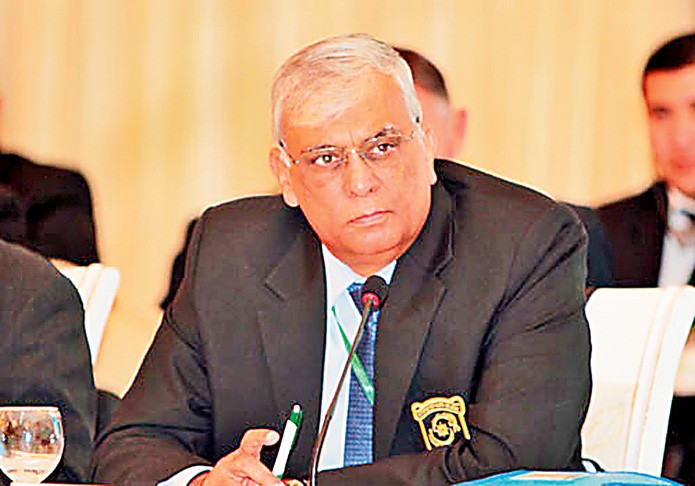

October 3, 2015, may go down in the annals of Pakistan sports history as a "Game Changer". Not that Pakistan won any world or Olympic title on this day, but for the first time a comprehensive and all inclusive vision of sports development in Pakistan was presented by the President Pakistan Olympic Association (POA) Lt Gen Arif Hassan (Retd) in Lahore, the headquarters of POA.
The time has perhaps come when the sports authorities in the country have decided to come to one page for solving the ravel of sports and look beyond the immediate, so that our glorious past can be revived.
The story of Pakistan sports administration is nothing short of a roller coaster ride of perennial conflicts between POA, PSB and self-serving national federations, but this time the troposphere was a bit different, as one could witness the presence of the majority of representatives of national federations, Minister of Inter Provincial Coordination (IPC) Riaz Hussain, federal and provincial sports secretaries, officials of Pakistan Sports Board, and towering personalities from the field of sports.
The president POA at the outset rightly admitted the fact that our aspirations were not in line with our preparations and the top-down approach doesn’t work anymore in the development of sports.
The presentation started with a memorable video clip of great Pakistani athletes Abdul Khaliq and Nawaz, titled "We were once Champions" that culminated on a noteworthy statement of President POA that "Gold doesn’t come easy" which was enough to set the tempo for the three hours long captivating presentation.
The mission statement around which the presentation revolved was: "To run a consistent, sustainable and collaborative sports development programme, providing the youth with the opportunity to participate in recreational and competitive sporting activities, allowing them to develop to whatever level they desire".
The presentation included an honest appraisal of past mistakes, identification of existing gray areas based on three vital aspects of genes, equipment and technological advancement in sports.
The POA chief talked at length about the development of elite sports and the politics in our sports system. He also exhibited his will to rise above the absurdity of conspiracy theories.
He focused on the bottom-up participatory approach of sports development, where grassroots sports development -- at education institutions and community sports clubs -- is given the most importance.
The role of policy makers, talent hunting and importance of scientific coaching, role of HEC and sport systems in various countries were discussed in detail.
He also touched upon the role of corporate sector, media and importance of "Genius Clusters" where specialist sportspersons can be developed through exclusive and focused training.
The secretary IPC showed his resolve and extended his full support in formulating a new national sports constitution as proposed by POA, which should be all inclusive and collaborative in nature to meet the aspirations.
He, however, passed the buck to POA to formulate a committee which should do the leg work and prepare a detailed document, covering all aspects of sports development in the country that can be placed in the shelf with a green ribbon on it, as we have done with all the previous policies and commission reports since 1967.
The main problem is that of sports leadership, sports education and managerial skills of the worthy sports federations and sports bodies.
For the last three decades, high-level athletes have no longer been amateurs in the sense of dabblers. They have become professionals. The same is true for sports managers and policy makers who nowadays manage considerable human, financial and material resources.
While Pakistan sports face major managerial inadequacies at the elite level to handle modern and complex sports development issues, the country also lacks sports activity at the grassroots.
The POA chief proposed a Sports Education programme for Army Public Schools (APS) and Cadet Colleges that can later be adopted by the rest of the education system in the country.
According to Baleegh-ur-Rehman, the Minister of State for Ministry of Education and Professional Training, the government is preparing a new Physical Education syllabus for schools. This sounds exhilarating, and one hopes that the government will focus at the training and capacity building of Physical Education teachers employed in schools and colleges who currently lack capacity to develop the motor skills and basics of sports among the students.
I visited the Atchison College in Lahore the same evening after the POA’s seminar to assess their sports activities.
The vast green fields and the age-old timber line of the college can mesmerise any visitor, and I was no exception.
However, I was extremely disheartened to see very less and mostly unsupervised sports activity in the elite college.
The situation is not different in other education institutions of the country, where adequate sport facilities are available but hardly any sport activity takes place. Education institutions and community sports clubs are the places where sports talent breeds.
On one hand PE teachers lack capacity and on the other no serious effort has ever been made in the education institutions to educate the parents about the importance of sports in holistic development of their wards.
Thomas Bach, President International Olympic Committee (IOC), while speaking at the recently concluded UN General Assembly meeting highlighted the importance of sport in education and the attainment of newly set 17 Sustainable Development Goals (STGs) by the UN.
Bach said, "Sport is not a distraction from education. It is a vital part of education."
Arif Hasan has given his vision and spelled out his strategic priorities which are athlete-centric in the post devolution scenario; however, the real task is to implement it.
The ravel will only be solved when all stakeholders join hands. The mission and strategic priorities will only prove to be the game changer if Higher Education Commission, the corporate sector, and the education system besides all sports federations and bodies of the country make a sincere and whole-hearted effort to come out of this despicable state of sports affairs.